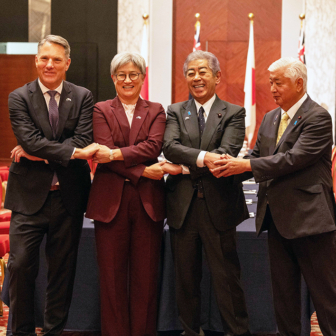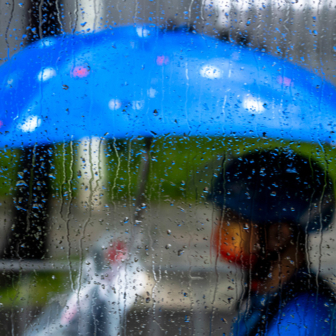As historians of empire, we’ve long been interested in, and frustrated by, colonial portraiture. These physical manifestations of the colonial gaze are the unreliable narrators of a moment of encounter — one that proved devastating for Indigenous peoples across world.
So what can colonial portraits tell us about the people they depict?
It’s the things that he’s lacking that I find most interesting: the tattoos and the ochre paint.
It does bring about a bit of a nostalgic, almost sense of loss, when I look at some of these things.
When I actually physically saw it at the British Museum, it was like looking at the family album. And I had to be really careful not to start tearing up from these watercolours.
These are just some of the responses we gathered in conversations and collaborations with Indigenous scholars and artists. Over three episodes, our podcast series “Unsettling Portraits” traces a brief but co-created history of modern colonial portraiture from its emergence in seventeenth-century North America to its practice in Australia and the Pacific in the eighteenth century, and then considers its resonance for many Indigenous artists today.
We talked with descendants of the Indigenous peoples represented in various historical portraits about what these images mean to them now. The results challenged, astonished and humbled us. Many saw loss and destruction. Others saw lies and erasure. A few found reasons for wonder, and even hope.
Our first guest, Native American writer Gordon Henry, talked with us about an image of one of his Anishinaabe ancestors from the Codex Canadensis, produced around the year 1700. Initially he was overcome by a sense of loss.
“I sometimes look at an image like this and just think about what did we lose in this process?,” he told us. “Is it that I don’t know this image so well because of something that was lost in the gaps of a colonial history that had these sort of… four-pronged spectres of religion, science, monarchy, and commerce? When those four things came into our world, sometimes conjointly, our lives changed, sometimes drastically for the worse.”
The sentiment was something we as historians of this era could understand all too well. But then Henry made us look at the image again. He said it also filled him with pride.
“The other side of [this] is that we have survived,” he said. “We’re still here. [They] did not overtake us or overcome us. We still know our history in ways that are separate, still do things that are separate ceremonially from all this. So yeah, we take that away from it for sure, so that along with that loss, we can also speak about the resilience of people, even through this compressed image-making of a whole group of people.”
Cherokee professor Joseph Pierce shared different insights when we discussed a 1762 portrayal of Ostenaco (above), one of his kinsmen. “I think about what it’s like for an Indigenous person to sit for a painting as opposed to a photograph,” he said. “And to sit and to be able to look at this person working and to be able to cast your gaze over the studio and the expression that the painter is making, and the negotiation that has to have happened. I refuse to believe that there was no negotiation, that there was no agency involved in this, knowing what we know about someone like Ostenaco.”

Ben-nil-long (1798). Engraving by James Neagle, 1760–1822. Cadell & Davies, London
We followed European colonists from North America to the South Pacific in the late eighteenth century, engaging with the ways portraiture worked in our part of the world. Darug scholar Jo Rey helped us make some sense of the infamous portrait of fellow Darug man, Bennelong, made in London in 1798 by the engraver James Neagle.
“What I’m seeing is the interpretation of the white colonising individual who’s painted it,” she observed, encapsulating much of what we had often thought about the value of colonial portraits of Indigenous individuals. But, she added, it also made her recall a Bennelong that is too seldom seen in Australia. It made her recognise him as a fellow “expat.”
She went on: “I guess I connect to Bennelong’s story with my own story of being an expat living outside of my language, my culture in Europe for seven years, and understanding what that expatriate experience is like.” The colonial image, despite its Europeanness, or perhaps because of it, clarified her Jo the ways in which Bennelong “was never going to be the same person… as he was before he left.”
The most unexpected twist in our collective research came about when we talked to Pacific artists. Thanks to Māori Professor Alice Te Punga Somerville and Samoan-Tahitian painter Michel Tuffery, we learned something quite new about the European practice of portraiture.

A Maori bartering a crayfish with an English naval officer (c. 1768–70), attributed to Tupaia. Courtesy of the British Library
Alice and Michel’s Polynesian ancestor, Tupaia from Ra’iatea, started turning this tradition back onto the imperialists as early as 1769. His images of both other Pacific people and of Europeans have inspired both of them for years. For Alice, they are “such a beautiful interruption to a kind of false narrative of the state as being Māori and European.” For Michel they mean nothing less than empowerment. When he saw the original watercolours in Britain, he said, “it was like looking at the family album.” Rediscovering these works has “woken us up.”
Our final episode turns to how Tupaia’s practice of Indigenous appropriation has carried on into the present. We talked to acclaimed Aboriginal artist Daniel Boyd about his nearly two-decades-long career extending the Indigenous reassessment of colonial portraiture. “When I was at the secondary level and my passion for art grew, I couldn’t really see myself or my people within the nation-building narrative that was being presented in the education system,” he explained. Boyd’s No Beard series from the early 2000s tried to rectify that absence. He took some “icons of nation building” — Joseph Banks, James Cook, Arthur Phillip — and “adjusted them,” chiefly by adding in “symbols of piracy.”
Aboriginal art critic Daniel Browning pulled our series to a close with these arresting words: “Colonial paintings, they have incredible power. They’re myth making. I call them beautiful machines for the production of lies.”
When Indigenous artists take on the tradition of colonial portraiture, he went on, “they’re coming to terms with, you know, what they’re learning. And it might not be about art. It’s about the history of Australia… You can see this in many artists as they progress through their careers. There’s always a reckoning with colonial imagery, of some kind.” •
Listen to the series here at the HistoryLab or via other podcast platforms.




